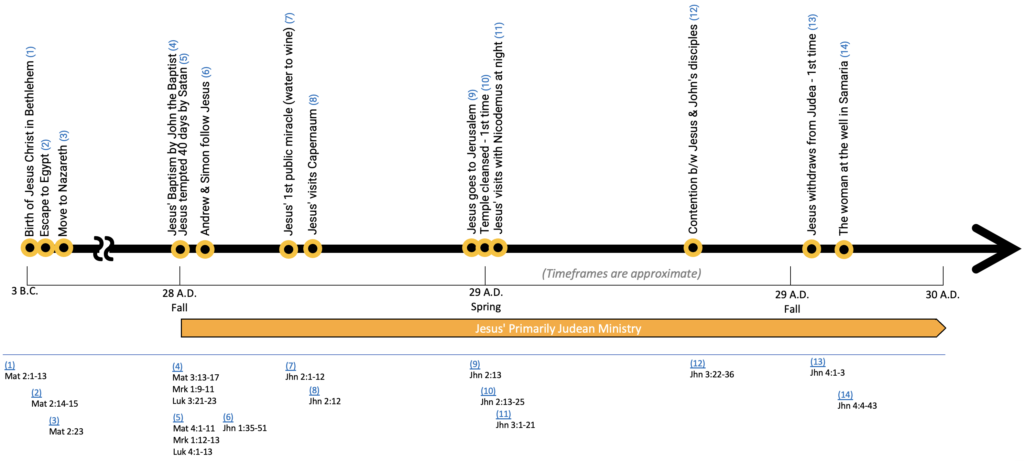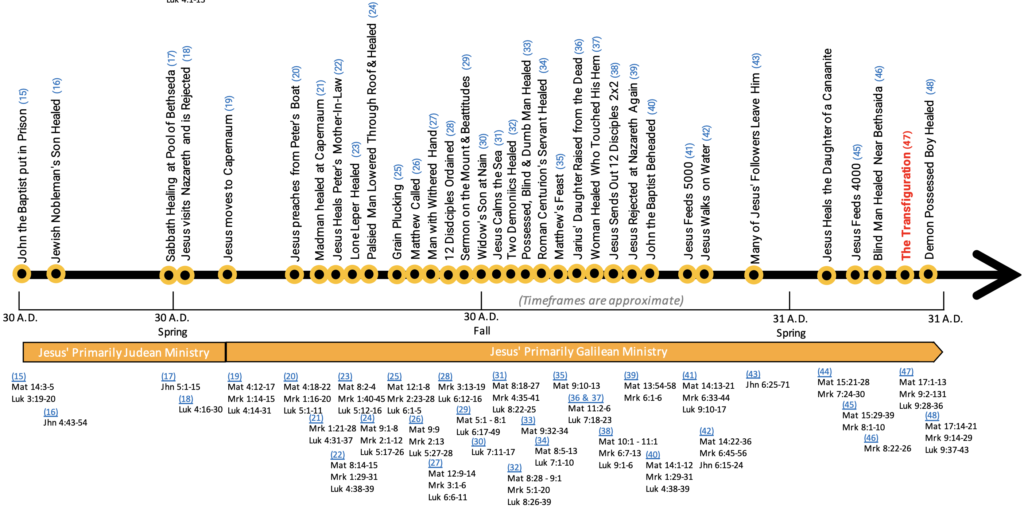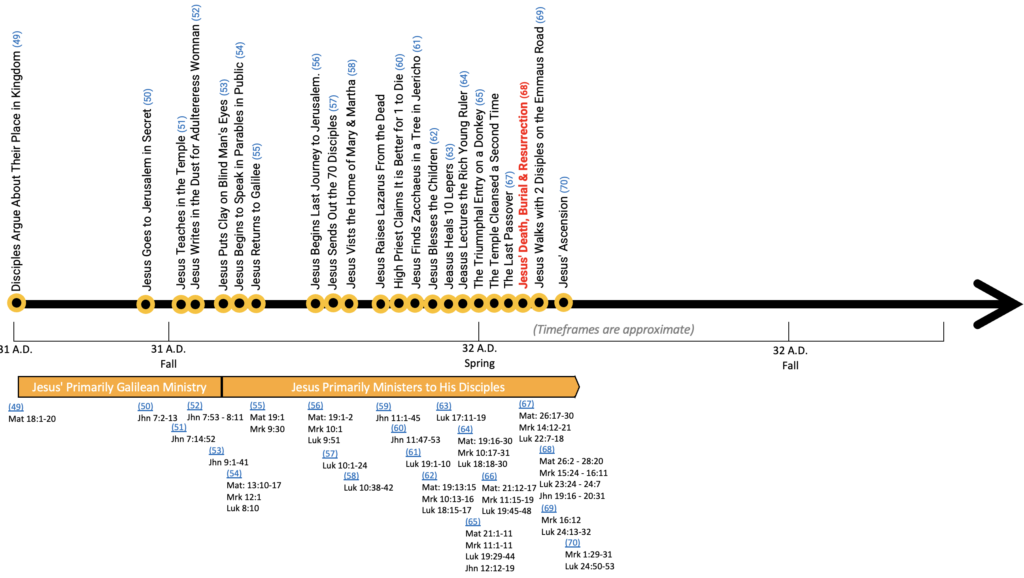Mark
Gospel of the Son of Man
Summary | About | Why You Should Read it | Author | When Written | Context | Timeline | Location | Outline | Observations | Resources
Summary
The Gospel of Mark portrays Jesus Christ as the suffering servant. Mark’s gospel is like a shooting script for a movie or a play. It moves rapidly through a series of visual images, emphasizing action. Mark continually uses a word “eutheos”, which is translated “immediately,” “straightway,” “forthwith,” etc. It appears over 40 times, which is about equal to the rest of the New Testament (only seven times in Matthew and only once in Luke).
Mark uses the “historical present tense” 150 times: Jesus comes, Jesus says, Jesus heals—all in the present tense.
There are more miracles recorded in Mark than in the other Gospels, despite its being the shortest. Matthew’s gospel seems longer because he includes the discourses—probably verbatim, having the skill to take them down in shorthand (as a customs official). Removing the discourses, it is shorter than Mark’s.
It takes only 20 short verses in Chapter 1 to describe the ministry of John the Baptist, Jesus’ baptism, His temptation in the wilderness, and the call of the disciples. This gospel focuses heavily on what Jesus did as the suffering servant.
The next table is a high-level look at the structure and contents of Mark.

About
Mark is the second gospel and second book of the New Testament. It is the shortest of the gospels but contains more miracles than any other.

Why You Should Read It
The Gospel of Mark provides a different perspective from the other 3 gospels. It portrays the ministry of Jesus Christ from the perspective of the suffering servant and from the perspective of the gentiles. In it we see what Jesus did and how it affected the people in the area at the time. See the intro to the Gospels for more information on the differences between the 4 gospels.

Author
The Author of the book was “John whose surname was Mark” (Act 15:3). John Mark was the son of a wealthy woman named Mary, probably a widow, whose home was large enough to serve as a meeting place for many of the early disciples after the Pentecostal outpouring (Acts 12:1-19).
When the rich young ruler questioning Christ about what he needed to do to inherit eternal life (Mark 10:17-22), Mark includes a detail that Matthew and Luke do not mention: “And Jesus looking upon him loved him…” (Mk 10:21). This hints at the possibility that young John Mark himself may have been that rich young man.
An early church tradition suggests that it was Mark who was the certain “young man” who followed Christ right up to His entry into the house of the high priest and then, when the guards tried to lay hold of him, left the linen cloth that he was clothed with in their hands and fled naked (Mk 14:51-52). Mark was the only one who included this incident.
Mark accompanied Paul and Barnabas to Cyprus, but later returned to Jerusalem, which deeply disappointed Paul (Acts 12:25; 13:13; 15:37- 39). Having felt abandoned, Paul refused to take him on the second journey, and thus began a bitter quarrel between Paul and Barnabas, to whom Mark was related: probably a cousin—not “nephew” (KJV); the word anepsios (Col 4:10) being used in Num 36:11, for “father’s brothers’ sons.”
Paul and Mark later reconciled when Paul was in prison in Rome. Mark served as his aide and then as a delegate on an important mission to Asia Minor (see Phile 24 and Col 4:10). Later Paul would ask Timothy to bring Mark back with him to Rome because he was useful in service (2 Tim 4:11).
When Peter was writing 1st Peter, he affectionately called Mark “his son” (1 Pet 5:13). It may have been Peter that originally led him to Christ. It was Mark’s intimacy with Peter that resulted in this intimate portrait of Christ.
When Written
The Gospel of Mark was likely written in the late-50’s to mid-60’s A.D. The exact date is not known. We know that Mark was with Paul during his first Roman imprisonment in the early 60’s.
Context
Mark likely wrote his gospel later in his ministry when he was with Peter in Rome. Mark’s purpose was to write down the Gospel as Peter had presented it to the Romans (so say the Fathers, at least, and internal evidence supports them). That the Gospel was for Gentiles can be seen:
a) From the translation of the Aramaic expressions
- Boanerges Mk 3:17
- Talitha cumi Mk 5:41
- Corban Mk 7:11
- Bartimaeus Mk 10:46
- Abba Mk 14:36
- Golgotha Mk 15:22
b) In the explanation of Jewish customs (Mk 14:12, 15:42). Matthew did not explain any Jewish customs, as his gospel was written to the Jews.
c) From the fact that the Law is not mentioned and the Old Testament is only quoted once in Mark’s own narrative;
d) The Gentile sections, especially in Mark 6 – 8.
That it was for Romans is seen in:
a) The explanation of a Greek term by a Latin (Mk 12:42).
b) The preponderance of works of power, the emphasis on authority (Mk 2:10), patience and heroic endurance (Mk 10:17 ff).
c) Forbids a practice that was not Jewish but Roman (Mk 10:12).
Those who believe it was written at Rome find further hints in the mention of Rufus (Mk 15:21; cf. Rom 16:13) and the resemblance between Mark 7:1-23 and Romans 14. The Roman centurion’s remark (Mk 15:39) is the style of the author, and bears the same relation to Mark’s purpose as to John’s (Jn 20:31).
Timeline
The Gospel of Mark begins with the preaching of John the Baptist in the wilderness and the baptism of Jesus. This was the beginning of Jesus’ ministry and concludes with Jesus’ ascension into heaven. It is the only gospel that does not contain a lineage of Jesus as He is presented as a servant.
Location
The Gospel of Mark takes place in Judea and Samaria, or throughout Israel.
Outline
The Beginnings of Jesus’ Ministry (1:1-13)
His Forerunner (1:1-8)
His Baptism (1:9-11)
His Temptation (1:12-13)
Jesus’ Ministry in Galilee (1:14; 6:29)
Early Galilean Ministry (1:14; 3:12)
Call of the First disciples (1:14-20)
Miracles in Capernaum (1:21-34)
Preaching and healing in Galilee (1:35-45)
Ministry in Capernaum (2:1-22)
Sabbath controversy (2:23; 3:12)
Later Galilean Ministry (3:13; 6:29)
Choosing the 12 apostles (3:13-19)
Teachings in Capernaum (3:20-35)
Parables of the kingdom (4:1-34)
Calming the Sea of Galilee (4:35-41)
Healing a demon-possessed man (5:1-20)
More Galilean miracles (5:21-43)
Unbelief in Jesus’ hometown (6:1-6)
Six apostolic teams preach and heal in Galilee (6:7-13)
King Herod’s reaction to Jesus’ ministry (6:14-29)
Strategic Withdrawals from Galilee (6:30; 9:29)
To the Eastern Shore of the Sea of Galilee (6:30-52)
To the Western Shore of the Sea (6:53; 7:23)
To Syrian Phoenicia (7:24-30)
To the Region of the Decapolis (7:31; 8:10)
To the Vicinity of Caesarea Philippi (8:11-30)
To the Mount of Transfiguration (8:31; 9:29)
Final Ministry in Galilee (9:30-50)
Jesus’ Ministry in Judea and Perea (ch. 10)
A. Teaching concerning Divorce (10:1-12)
The Teaching concerning Children (10:13-16)
The Rich Young Man (10:17-31)
A Request of Two Brothers (10:32-45)
The Restoration of Bartimaeus’s Sight (10:46-52)
Passion of Jesus (chs. 11-15)
The Triumphal Entry (11:1-11)
The Clearing of the Temple (11:12-19)
Concluding Controversies with Jewish Leaders (11:20; 12:44)
Signs of the End of the Age (ch. 13)
The Anointing of Jesus (14:1-11)
The Lord’s Supper (14:12-26)
The Arrest, Trial, and Death of Jesus (14:27; 15:47)
Resurrection of Jesus (ch. 16)
Observations
- The writer of Mark is John Mark.
- John’s mother had a large house that was used as a meeting place for the church in Jerusalem.
- According to Acts 12:12, Barnabas and John Mark were cousins.
- It may be that Peter led Mark to Christ. 1 Peter 5:13 – “Mark my son.”
- Barnabas & Saul took John Mark with them when they returned from the Jerusalem conference in Acts 15.
- Mark proceeded with them on the 1st missionary journey.
- Mark turned back in Phyrgia in Pamphylia, and returned to Jerusalem.
- When Barnabas wanted to take Mark with them on the 2nd missionary journey, Paul refused. The disagreement led to:
- Barnabas taking Mark and traveling to Cyprus.
- Paul taking Silas and traveling through Syria and Cilicia.
- Eventually matters worked out between Paul and John Mark as is evidenced by:
- Approximately 12 years later Paul wrote that Mark was with him during his first Roman imprisonment.
- Near the end of his life, Paul wrote in 2 Timothy 4:11 – “Get Mark and bring him with you, for he is useful to me for ministry.”
- Of the four books of biography (Matthew, Mark, Luke, & John), the Book of Mark is the shortest of the four.
- Whereas Matthew was written for a Jewish audience, it appears that Mark was written for Roman readers.
- The Book of Mark stresses the works of Jesus rather than the words of Jesus.
- Only four parables are given in Mark.
- 19 miracles are recorded in rapid fashion.
- The quick succession of events in Mark is indicated by one Greek word which occurs 41 times in the book and is translated by seven different words:
- As soon as”
- “Shortly”
- Straightway”
- “Immediately”
- “Anon”
- “Forthwith”
- “By and by”
- Mark records the effects of amazement, fear and awe that the miracles of Christ had upon the people.
Sections in Mark
- Introduction & Preparation 1:1-1:13
- The Servant at Work 1:14-8:30
- The Servant Reject, Then Exalted 8:31-16:20
Theme
- Jesus is the suffering servant, who gives His life to save the world.
- The focus of this gospel is aimed at the Roman audience of the day, being penned by a Roman.
- Mark’s gospel is action oriented and does not describe in detail the events but gives short snippets of what He accomplished.
Jesus in Mark
Jesus suffered and died so that salvation would be available to all people (10:45).




